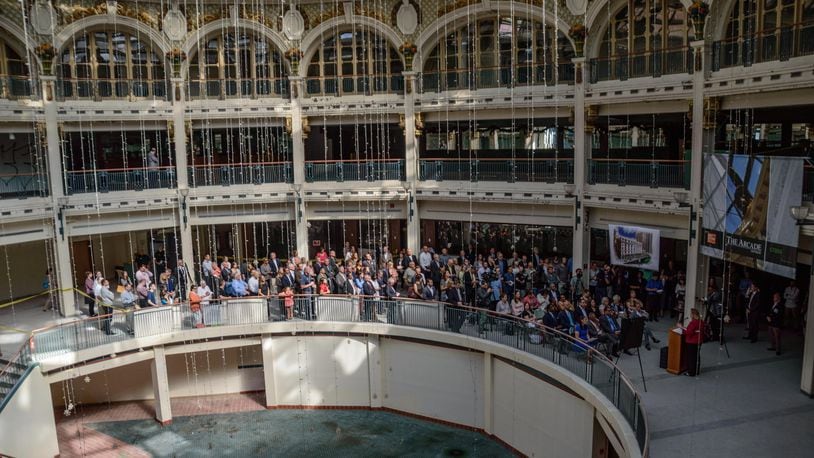“This is big. It’s really important,” said John Gower, urban design director of CityWide. “Nine million dollars in state historic tax credits is a scale of an award that the Dayton area has never seen before.”
RELATED: New Dayton Arcade plans: Pop-up restaurants, micro apartments, ‘secret tenant’
The arcade received $5 million in state historic tax incentives six months ago, and the project also has been awarded tens of millions of dollars in new-market and low-income housing tax credits.
But the developers’ plans are ambitious and expensive, and officials say they require assembling a complicated package of financing in which every funding piece is important, especially historic tax credits.
Residents who have hoped for years that the arcade could be restored and reopened will have to wait until the end of the year or possibly early next year to find out if the project is actually going to happen.
But officials are increasingly optimistic that the arcade will be returned to its former glory.
“Yeah, we can definitely see the finish line,” said Dave Williams, Miller-Valentine Group’s vice president of urban development.
RELATED: These unique details inside the Dayton Arcade made it beloved in its heyday
On Tuesday, the Ohio Development Services Agency announced it awarded the Dayton Arcade $4 million in state historic preservation tax credits for a nearly $41 million phase of the project.
Developers propose to rehab the arcade in phases, beginning with new housing for artists and creative types and professionals, event spaces and a hub for entrepreneurs, students, faculty, businesses and other groups.
In June, the first phases of the project were awarded $5 million in state historic tax credits.
The $56 million early stages of renovation will focus on the southern buildings, including the rotunda and the Commercial and Fourth Street Apartment buildings. The Dayton Arcade consists of about eight interconnected buildings.
RELATED: Living in the Dayton Arcade: What you need to know
The tax incentives announced Tuesday will support the restoration of the Third Street Arcade, Gibbons Annex and the McCrory buildings.
Cross Street Partners, which did not immediately return calls for comment, wants to work with Miller-Valentine Group to make the Third Street Arcade into first-floor retail spaces and offices and small apartments on the upper levels.
The Third Street Arcade has a two-story, sky-lit retail arcade. The retail spaces will be filled by a collection of pop-up restaurants.
RELATED: Downtown project wins tax incentives — but not the Dayton Arcade
The McCrory building will house University of Dayton art programs in the basement and first floor, and its upper floors will have spaces related to the innovation center, according to the developers’ application for tax credits.
The proposed rehab of the arcade is expensive because of the complex’s deteriorated condition and the specialized construction needs of the project, the developers said.
“Market conditions in Dayton will not support the cost without some outside incentive,” the application states.
The development team is finalizing construction numbers that will help determine the financial structuring of the project, which is very complicated because of the many different funding sources, said Dayton City Manager Shelley Dickstein.
Previous proposals to rehab the arcade did not even get past the pre-development phase, while the current project has made considerable and impressive progress and has been allocated large amounts of tax incentives, she said.
“This is by far the most complicated development project at least in my 20 years,” Dickstein said.
Developers say they have been working hard to ensure they are grandfathered in under the old federal historic tax credit rules, because the program is expected to change under the Republican tax reform plan.
The arcade project planned to use more than $16 million in federal historic tax credits, according to its applications for state credits.
“That’s been our big push to make sure we don’t potentially lose out on everything we set up,” said Williams.
About the Author
